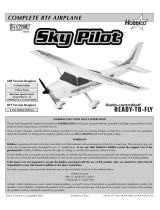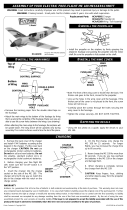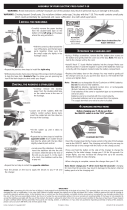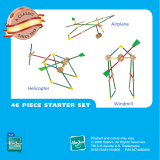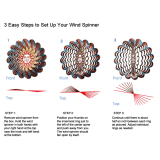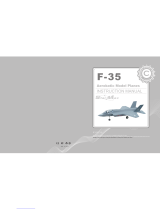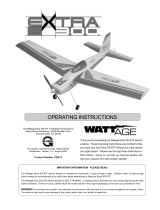Page is loading ...

ASSEMBLE ONLY WITH ADULT SUPERVISION
Please read through this instruction booklet to THOROUGHLY familiarize yourself with the assembly and flight
characteristics of this airplane before beginning to assemble this model.
Please inspect all parts carefully before starting assembly! If any parts are missing, broken or defective, or if you have any
questions about the assembly or flying of this airplane, please call us at (217) 398-8970 and we’ll be glad to help.
WARRANTY
Hobbico
®
, Inc. guarantees this kit to be free from defects in both material and workmanship at the date of purchase. This
warranty does not cover any component parts damaged by use or modification. In no case shall Hobbico’s liability exceed the
original cost of the purchased model. Further, Hobbico reserves the right to change or modify this warranty without notice.
In that Hobbico has no control over the final assembly, no liability shall be assumed nor accepted for any damage resulting
from the use by the user of the final user-assembled product. By the act of using the user-assembled product, the user accepts all
resulting liability.
If the buyers are not prepared to accept the liability associated with the use of this product, they are advised to return this
kit immediately in new and unused condition to the place of purchase.
To make a warranty claim send the defective part or item to Hobby Services at the address below:
Hobby Services
3002 N. Apollo Dr., Suite 1
Champaign, IL 61822
USA
Include a letter stating your name, return shipping address, as much contact information as possible (daytime telephone
number, fax number, e-mail address), a detailed description of the problem and a photocopy of the purchase receipt. Upon receipt
of the package the problem will be evaluated as quickly as possible.
C
C
OMPLETE R
OMPLETE R
TF
TF
AIRPLANE
AIRPLANE
Requires 8 “AA” Alkaline
Batteries (not included)
Quiet Electric Flight
Radio-Controlled Model
Entire Contents © Copyright 2005 HCAZ3050 for HCAA2008 V1.0
™
™
Instruction Manual

Thank you for purchasing the Hobbico Mini Ventura
™
.
The Mini Ventura capitalizes on the success of its big
brother, the Ventura, only in a smaller package that can
be flown in even smaller areas. Although the Mini
Ventura is a small, durable, easy-to-fly model, it would
still be a great idea to get the assistance of an
experienced modeler for your first flights. Once you
have learned the basics and perfected your hand-eye
coordination, you’ll be able to enjoy countless, trouble-
free flights with your Mini Ventura. Please read all of the
safety precautions and the instructions to ensure the
best possible experience with your Mini Ventura.
1. Your Hobbico Mini Ventura is not a toy, but rather a
sophisticated, working model that functions very much
like an actual airplane. Because of its realistic
performance, the Mini Ventura, if not assembled and
operated correctly, could possibly cause injury to
yourself and spectators or damage property.
2. Assemble the plane according to the instructions. Do
not alter or modify the model. If you make any
modifications, you will void your warranty.
3. Testing has proven that the Mini Ventura may be flown
by experienced pilots in winds of up to 15mph, but
beginners should fly the Mini Ventura only when wind
speeds are 5mph or less. The Mini Ventura should be flown
only in large, open areas free from trees, people, buildings,
telephone or electric lines or any other obstacles.
4. The Mini Ventura is offered on six different channels
(1 through 6) that are on a “shared” frequency band of
27 MHz (mega Hertz). This means that both the Mini
Ventura and ground-based models (cars and boats) may
use these channels. If two or more models are being
operated in the same area on the same channel, radio
interference may occur resulting in a crash of one or
both models. You should be especially aware of radio
controlled model airplane club sites that may be near
by. Always look for other R/C activity in the area. If there
is another R/C model being operated, kindly ask the
pilot/driver what is his frequency (channel). Do not
operate your models at the same time if you are both
on the same frequency.
The best way to avoid radio interference (and to get
flight instruction) is to join an R/C club where frequency
control measures will be in effect. If you insist on flying
elsewhere, always be aware of your proximity to R/C
flying sites and other modelers who could be using the
same frequency as you.
If you’re an inexperienced modeler, we recommend
that you get assistance from an experienced,
knowledgeable modeler to help you with assembly and
your first flights. You’ll learn faster and avoid risking
your model before you’re truly ready to solo. Your local
hobby shop has information about flying clubs in your
area whose membership includes qualified instructors.
You can also contact the national Academy of Model
Aeronautics (AMA), which has more than 2,500
chartered clubs across the country. Through any one of
them, instructor training programs and insured
newcomer training are available. Contact the AMA at
the address or toll-free phone number below.
Academy of Model Aeronautics
5151 East Memorial Drive
Muncie, IN 47302
(800) 435-9262
Fax: (765) 741-0057
or via the internet at: http://www.modelaircraft.org
Attention: The Mini Ventura is powered by a rechargeable
battery. At the end of the battery’s useful life, under various
state and local laws, it may be illegal to dispose of the
battery into the municipal waste system. Check with your
local solid waste officials for details in your area for
recycling options or proper disposal.
This product contains a chemical known to the state of
California to cause cancer and birth defects or other
reproductive harm.
PROTECT YOUR MODEL, YOURSELF
AND OTHERS.
FOLLOW THIS IMPORTANT SAFETY
PRECAUTION
INTRODUCTION
2

Vertical Stabilizer (Fin): Vertical tail wing that stabilizes
the model in the “right/left” direction by keeping the tail
behind the nose.
Rudder: Movable surface connected to the fin. Controls
the turning direction of the model.
Horizontal Stabilizer (Stab): Horizontal tail wing that
stabilizes the model in the “up/down” direction.
Elevator: Movable surface connected to the stabilizer.
Controls the main wing angle to make the model climb
or descend.
Transmitter (Tx): Hand-held control box operated by
the pilot that sends signals to the receiver to control the
model for flying.
Receiver (Rx): Electronic unit in the airplane that
receives signals from the transmitter and relays them to
the servos to operate the controls.
Servo: An electronic unit inside the model with a small
motor, gears and an external arm that moves the
pushrod connected to the control surface (elevator and
rudder for the Mini Ventura).
Electronic Speed Control (ESC) with Auto Cut-off: Electronic
unit in the airplane that controls the speed of the motor.
When the battery voltage drops to a certain point the
ESC will automatically cut off the motor, reserving
enough battery power to operate the radio while you
glide and land the airplane.
Trim Tabs: The sliding tabs on the transmitter that allow
fine adjustments of the control surfaces.
Volt (V): A Volt is a measure of a battery’s “muscle.” The
battery pack for the Mini Ventura is made up of five
individual 1.2V batteries. Connected together the total
Voltage is 6 Volts (1.2 x 5).
Ampere (A): An Ampere, or “Amp,” is a measure of the
flow of electricity, or “current.” A milliamp (mA) is one
one-hundredth of an Amp.
Milliamp-Hours (mAh): Indicates the “size,” or capacity
of a battery pack (and how much energy it can store).
The capacity of the Mini Ventura’s battery is a 600mAh
(.6Ah), so if the battery was connected to an electric
motor that required .6A to run, the battery could run the
motor for about one hour. However, at full power the
Mini Ventura’s motor uses about 7 Amps, so it will run
for about five minutes on the 600mAh battery (.6Ah
battery/7A = .086 hours (5.2 minutes).
Nickel-Metal Hydride (NiMH) Battery: There are a few
different types of rechargeable batteries. The Mini
Ventura battery pack is a rechargeable NiMH battery.
NiMH batteries are lighter and smaller than most other
types of rechargeable batteries.
GLOSSARY
3

4
KIT INSPECTION
1
3
2
4
7
8
9
11
12
13
10
Kit Contents
1. Transmitter
2. Instructional DVD
3. Transmitter Antenna
4. Wing
5. Fuselage
6. Spare Spinner
7. Spare Folding Propeller
8. Spare Fin Mounting Nuts
9. Wing Rubber Bands
10. Stabilizer and Elevator
11. Fin and Rudder with Fin Mounting Nuts
12. Battery Charger and Adapter Plug
13. Spare Fuses
Before starting assembly, take an inventory of this kit to make sure it is complete, and inspect the parts to make
sure they are of acceptable quality. If any parts are missing or are not of acceptable quality, or if you need
assistance with assembly, contact Product Support. When reporting defective or missing parts, use the part names
exactly as they are written in the “Kit Contents” list on this page.
Hobbico Product Support:
3002 N. Apollo Drive, Suite 1
Champaign, IL 61822
Telephone: (217) 398-8970 ext. 3
Fax: (217) 398-7721
E-mail: [email protected]
5
6

❏ 1. Unscrew the fin mounting nuts from the fin
mounting rods.
❏ 2. Holding the parts in your hands, connect the
pushrods to the middle hole in the control horns on the
elevator and rudder. (You can get a closer look in the
bottom, two photos on this page.)
❏ 3. Join the fin and stabilizer to the fuselage by
inserting the threaded rods down through the stabilizer
and the fuselage. Note: Use care not to push the rods
through the wire receiver antenna inside the fuselage.
This is how the pushrods should look when connected
to the control horns on the elevator and rudder.
ASSEMBLY
FLYZONE 3-CHANNEL FM
TRANSMITTER (TX)
5

❏ 4. Push the fin and the threaded rods all the way
down, then install and tighten the fin mounting nuts
enough to apply slight pressure holding all the parts
together with no gaps.
❏1. If you have not already done so, insert the antenna
into the top of the transmitter and tighten with your
hands (do not use pliers or any other tool).
❏ 2. Install eight “AA” alkaline batteries in the back of
the transmitter and then replace the battery cover. Note:
Alkaline batteries are preferred over rechargeable
batteries because alkalines have a higher voltage.
❏3. Center the rudder and elevator trim levers. Move the
rudder servo reversing switch to the up position and the
elevator servo reversing switch to the down position.
❏ 4. Move the throttle lever on the transmitter all the
way to the left (when viewing the transmitter from the
front), to the off position.
❏ 5. Switch on the transmitter. Check the battery
condition. Both the red and green lights should glow.
When the green light becomes dark the batteries are too
low and the model should not be flown. If the green
light becomes dark while flying, land the plane
immediately or loss of control may result.
IMPORTANT!!! ALWAYS reduce the throttle lever and
turn on the transmitter before plugging in the battery.
Similarly, NEVER plug in the battery before reducing
the throttle lever and turning on the transmitter.
FLIGHT PREPARATION
6

❏ 6. Install the battery. Connect the battery to the plug
in the fuselage. Tuck in the wires so the hatch can close.
❏ 7. With the transmitter turned on, the trims centered
and the battery plugged in, view the elevator from the
rear. If necessary, bend the “Z” portion of the elevator
pushrod to get the elevator centered.
❏ 8. Center the rudder the same way. Note: The
procedure of centering the rudder and elevator must be
done with the radio system on and the trims centered.
❏ Use a fine-point felt-tip pen to write your name,
telephone number and address directly on the model, or
write it on a piece of masking tape and apply it to
the model.
❏ 1. Use a straightedge and a fine-point felt-tip pen to
mark two lines on the bottom of the wing 1" [25mm]
and 1-1/4" [32mm] from the leading edge indicating the
balance range.
❏2. Install the battery (it is not necessary to hook it up).
❏ 3. Mount the wing to the fuselage with two
rubber bands.
BALANCE YOUR MODEL
IDENTIFY YOUR MODEL
PREFLIGHT
7

❏ 4. Lift the model with two pencils, placing one on
each side of the wing between the lines. Adjust the
model on the pencils until the fuselage is level when
viewed from the side. (For illustration purposes, a stand
was made in the shop, but household items such as
pencils or pens are suitable for the balancing
procedure.) If the model balances with the pencils
between the lines, then the center of gravity is correct
and the model is ready to fly.
❏ If the model balances with the pencils ahead of the
lines, weight will have to be added to the tail to get it to
balance. Tail weight may be stuck to the side of the
fuselage or to the bottom of the stabilizer.
❏ If the model balances with the pencils behind the
lines, weight will have to be added to the nose to get the
model to balance. Stick-on lead weight may be
purchased from the hobby shop. Nose weight may be
stuck to the inside of the hatch.
❏ 5. Stick on as much weight as required to get the
model to balance when lifted by the pencils between
the lines. If you added any weight, recheck the balance.
❏ 1. The battery should always be discharged before
charging. It takes 40 minutes to charge the battery for the
Mini Ventura. If the battery is not discharged, a 40-minute
charge will overcharge the battery. If it has been a while
since you last flew your Mini Ventura, or if for any other
reason you do not remember how much “charge” is left in
the battery, it should first be discharged before charging. To
WARNING: DO NOT overcharge the battery!
Unless you have just completed a flight and run the
battery all the way down, there is no way to know
how much charge is left. Overcharging the battery
may result in melting the plastic cover, damaging the
vehicle, or causing the battery to explode.
BATTERY CHARGING SAFETY
PRECAUTIONS
WARNING: Before charging the battery you must
read and follow ALL of the Battery Charging Safety
Precautions and the Battery Charging Instructions.
BATTERY CHARGING
8

discharge the battery, install and connect it to the model.
Turn on the transmitter and run the motor until it stops and
the battery has been discharged. Now the battery is ready
to be charged.
❏ 2. Never charge the battery while the car engine is
running. This will increase the output of the charger and
overcharge your battery.
❏ 3. Always place the batteries and charger outside
the car while charging.
❏4. Frequently touch or handle the battery to monitor
its temperature while charging. Use caution while
touching the battery as it could become hot if
overcharged. It is okay and normal for the battery to be
warm to the touch, but never allow it to become hot. If
the battery has become hot it is overcharged and should
be disconnected from the charger immediately.
❏ 5. Never leave a charging battery unattended.
❏6. If you ever use a different battery charger, charge this
battery pack only at a maximum charge rate of 500mA
(1/2 Amp). A higher charge rate will charge the battery
pack too quickly and heat up the wires.
❏ 7. A properly cared for battery pack will last a long
time. If the battery pack is continually overcharged or
charged at too high of a rate, the life of the battery pack
will be shortened.
❏ 8. After each flight, remove the battery pack from the
airplane and allow it to cool completely before recharging.
❏1. IMPORTANT!!! Discharge the battery by installing
it in the model and running the motor until it stops.
❏ 2. Set the Voltage switch on the charger to the 6V
setting all the way over to the right. Always make sure
the switch is in the 6V setting before charging the
battery for the Mini Ventura.
❏3. Connect the battery charger to a 12-volt accessory
socket (cigarette lighter) in a vehicle. The vehicle’s
engine must not be running. Place the charger outside
the vehicle. Do not let the battery or charger hang by
the wires. If necessary, place the charger and battery on
a stand.
❏4. Connect the battery pack to the charger. Note: The
plug will fit only one way.
❏ 5. Rotate the timer dial to 30 minutes. The red light
on the charger will illuminate when the battery is
charging. If the red light does not illuminate, check the
connection between the charger and the 12-volt
accessory socket (cigarette lighter) and between the
charger and the battery.
❏ 6. After the timer has stopped, reset the dial to an
additional 10 minutes – no more than 10 additional
minutes or the battery will overcharge!!
WARNING! NEVER LEAVE A CHARGING BATTERY
UNATTENDED.
❏7. During charging, periodically feel the battery to see if
it is becoming warm. A warm (but not hot) battery pack is a
sign that it is fully charged. Once the pack is warm,
disconnect it from the charger. Depending on how much
charge was already in the pack, you may have to disconnect
the battery before the 40 minutes are up.
❏8. When the timer dial has returned to “0” disconnect
the battery from the charger and disconnect the charger
from the vehicle.
Though the Mini Ventura is a “Park Flyer,” the best place to
fly any model is at an AMA chartered club field. The AMA
address and telephone number are on page 2.
IMPORTANT!!! When flying at a radio control model
airplane club flying site, never turn on the transmitter
until you have the matching frequency pin in your
possession indicating that there is no one else flying
on your frequency.
FIND A SUITABLE FLYING SITE
BATTERY CHARGING INSTRUCTIONS
9

If not flying at a model airplane flying site, find an area
clear of trees, power lines and other structures. Do not
fly within 6 miles of existing R/C flying fields or around
groups of people–especially children.
Review these flying procedures so you will have an idea
of what to expect when you meet your instructor.
Place the wing on the fuselage. Center the wing from
side-to-side, aligning the arrows with the seam on the
top of the fuselage. First secure the wing with four
rubber bands–one on each side, then with two more
rubber bands in a crisscross fashion.
Tie the red ribbon to the tip of the transmitter antenna. This
will serve as a wind flag to indicate the wind direction.
Always take off and land into the wind.
Don’t forget to scan the area for other modelers who
may be operating R/C models that may be on the same
frequency as you.
Fully extend the transmitter antenna. Make sure the
throttle lever is in the off position and then turn on the
transmitter. Install the battery; then plug it in. Be careful
not to inadvertently bump the motor start button.
Check the controls before every flight by moving the
control stick in all directions, observing how the
controls react, and making sure they respond in the
correct direction. Most malfunctions can be discovered
by performing this simple, last-second procedure,
saving your model from a crash.
Perform a range check before each flying session of the
day. Do not push the motor start button during the first
range check. With the antenna collapsed, walk 50 feet
[15m] from the airplane. Move the rudder and elevator
control stick, making sure the controls respond. Have an
assistant hold the airplane and press the motor start button
to start the motor. Perform the range test with the motor
running. The controls should respond as expected. If there
are any “glitches” or unexpected control movements, the
plane is not safe to fly. Make sure the transmitter batteries
are in good condition and make sure the motor battery in
the plane is adequately charged.
Extend the transmitter antenna. Do not press the motor
start button until you are actually ready to launch the
airplane. Scan the area one last time to make certain
there are no spectators, or that any spectators present
are standing behind you.
Hold the transmitter in your left hand and hold the
airplane in your right hand (or better, have your assistant
Caution: It is likely that the Mini Ventura will not fly
straight ahead on the first launch. It may suddenly
dive or climb or turn to the right or the left. This is
impossible to predict because the model has not yet
been adjusted, or “trimmed” for straight-and-level
flight. Even though the controls were centered
visually at home, minor trim adjustments will
probably still be required to get the model to fly
straight. This means you will have to be ready on the
control stick to give corrections immediately after
launching. Instructions are provided for how to trim
the model after it has reached a comfortable altitude,
but until then continual control stick input may be
required. After the model has been trimmed it should
fly straight-and-level on its own–this will make the
next hand launch easier. Just remember to be ready to
give immediate control stick inputs after launching.
TAKE OFF
CHECK THE CONTROLS
OPTIONAL: INSTALL THE WIND FLAG
MOUNT THE WING
FLYING
10

launch the model). When ready to launch, raise the
model over your head and point the nose directly into
the wind. Press the motor start switch, fully advance the
throttle, then toss the model into the air at a level, or
slightly nose up attitude. Make sure you launch with the
wings level. Note: A good launch is important–it would
be better to gently toss the model rather than throw it
into the air at a bad angle that will make recovery
difficult. Be careful on your first launch and make sure
you get it going straight ahead and into the wind.
Immediately transfer your right hand to the transmitter
so you can operate the control stick. Use the control
stick to steer the Mini Ventura straight ahead while
establishing a gradual climb.
When you get to a comfortable altitude make your first
turn AWAY from yourself and any spectators that may
be present. Generally (but not always), slight “back
pressure,” or “up” elevator will be required to maintain
altitude during turns.
Here are a few things to keep in mind while flying
your Mini Ventura:
1. Don’t let it fly too far away. The farther away, the
harder it will be to see what the Mini Ventura is doing
and give the correct control inputs to fly it back.
2. When learning, it is best to keep the plane high
enough so that if you make a mistake, you have enough
altitude to make corrections.
Your first objectives will be to gain altitude (so you will
have time to think and react) and make the first turn (so
the model does not get too far away). When the plane is
flying away from you, the Mini Ventura will respond the
way you would expect; moving the rudder stick to the
right will make the plane turn to your right. When the
Mini Ventura is flying toward you it appears to respond
in the opposite direction, but in actuality it is
responding the same way; moving the rudder stick to
the right will still make the plane turn to its right, but
when it is facing you it will turn to your left. Beginning
modelers can avoid this initial disorientation by turning
their body away from the model and holding the
transmitter so they are facing the same direction that it
is flying. In this case you will have to look over your
shoulder until the model passes by.
The next objective is to trim the plane for straight-and-
level flight. With the Mini Ventura flying directly into the
wind, see what it does when you let go of the control stick.
It should fly straight-and-level. If the Mini Ventura climbs,
it will need some down trim. Push the elevator trim tab
forward (giving it down trim) until the Mini Ventura flies
level. Do the opposite if the Mini Ventura dives when the
control stick is released. If the plane turns to the left when
the control stick is released, move the rudder trim tab to
the right until it flies straight, and vice versa. Continue to
adjust the trims so the Mini Ventura will fly straight when
going into the wind.
The last exercise for your first flight will be to turn off the
motor and see how the MIni Ventura reacts so you will
know what to expect when it’s actually time to land.
Again, flying into the wind, reduce the throttle and
observe how your Mini Ventura reacts. It should just
glide straight ahead and establish a gentle nose-down
attitude. Allow the model to glide as long and far as you
like–you can even execute turns. When ready, apply full
power and regain altitude. Do this a few times to get
used to power-off flight.
Remember, the Mini Ventura is a “motor glider,” so you
can turn off the motor at any time. In fact, flying with the
motor off is the best way to extend flight time. Use full
power to climb to a high altitude, then shut the motor
off and glide. When you’ve lost too much altitude apply
power and climb back into the sky. In conditions where
there is no rising air, flight times of 8 to 11 minutes
should be possible. When there is rising air, or “lift,”
indefinite flight times are possible.
Attempt a few practice landing approaches before the
battery discharges so you can see what it will be like to
land–without actually doing so. This is done by cutting
the power, allowing the Mini Ventura to lose altitude
and gliding it by in front of you five or so feet [1.5m]
above the ground. After it gets too low add full power,
climb out and go around again. This will give you an
indication of what to expect, how to line it up with your
landing spot and how much room it will take to land.
When you are ready to do a practice landing cut the
power when the model is flying downwind (with the
wind) in front of you. Make a turn into the wind allowing
the Mini Ventura to lose altitude. Be ready to apply power
if you get too far away or too close to the ground. You can
always apply power, then cut power as needed to bring it
LANDING
FLIGHT
11

closer in. Allow the MIni Ventura to glide by about ten feet
[3m] in front of you. When it gets too low or after it goes
by add power and do it again. When you are ready to
actually land do the same thing, only this time simply
don’t add power. As the Mini Ventura gets closer to the
ground apply more and more “up” elevator until it slows
to a stop–right on the ground. The propeller will fold back,
preventing damage.
Retrieve the model and make a post-flight inspection by
looking at the propeller, wings and tail for any damage.
If any elevator trim was required, take a look at the
elevator and make a mental note of its position. With
the transmitter on and the battery plugged in, return the
elevator trim tab to center, then bend the pushrod as
shown in step 7, on page 7, until the elevator will be in
the same position it was before you centered the trim.
Do the same with the rudder. The idea is to have the
model fly straight-and-level with the trims centered.
Unplug the battery, then turn the transmitter off. Remove
the battery and allow it to cool before recharging. Allow
the motor to cool before the next flight.
Caution: If the propeller is ever stuck and cannot rotate
when power is applied, the battery and speed controller
will overheat. Immediately cut the throttle lever to stop
the motor. If you fail to do this, the motor, speed control
and/or battery will be damaged.
In the hands of intermediate or advanced pilots the Mini
Ventura is capable of aerobatics. Among many thrilling
maneuvers, stall turns and loops are fairly easy and fun.
When ready to attempt aerobatics, move the elevator
and rudder pushrods to the inner holes on the control
horns. This will require temporary removal of the fin and
stabilizer so the bends in the pushrods can be guided
out of the holes. The closer in on the control horns that
the clevises are, the more control throw the control
surfaces will have and the more aerobatic the Mini
Ventura will be.
Beginners should not attempt aerobatics until…they are
no longer beginners and are able to react quickly and
get the model out of adverse situations or avoid adverse
situations altogether!
Stall Turn: First attempts at stall turns should be initiated
with plenty of altitude and with the wind, so that the
maneuver finishes into the wind. Stall turns are best done
off to the left or right of the pilot. Fly the model straight-
and-level under full power. Pull elevator until the model is
vertical. Allow the model to climb vertically while
reducing power to half-throttle. Just before the model
stops its vertical ascent, apply full left rudder until the
model pivots around the wing and is now pointing
downward. Continue the vertical dive until the Mini
AEROBATICS
AFTER FLIGHT
12

Ventura has gained enough speed to level out and re-enter
straight-and-level flight as you apply full power.
Loop: Loops should always be done into the wind. A
proper loop should be done on-center, in front of the
pilot. Fly straight-and-level under full power. Gradually
pull up elevator, allowing the model to perform the
loop. After the model passes through the top of the loop
reduce power. As the model completes the loop apply
full power and relax the elevator to return the model to
straight-and-level flight.
Minor damage to the wing and tail parts can be repaired
with epoxy. Use tape to hold the parts together while
the epoxy hardens.
Do not attempt to repair a damaged propeller. Minor
chips or scratches to the tips of the propeller are
acceptable, but performance may be reduced. If the
propeller ever suffers major damage such as cracks near
the base of the blade, the propeller must be replaced. To
replace the propeller use a small Phillips screwdriver to
remove the spinner, then loosen the screws in the hub.
Replace the propeller and hub, tighten the screws, then
replace the spinner. Be certain the spinner and propeller
hub can spin freely and are not contacting the fuselage.
Replacement parts for the Hobbico Mini Ventura are
available using the order numbers in the “Replacement
Parts List” that follows. The fastest, most economical
service can be provided by your hobby dealer or mail-
order company. Parts may also be ordered directly from
Hobby Services, but full retail prices and shipping and
handling charges will apply. Illinois and Nevada residents
will also be charged sales tax.
To locate a hobby dealer, visit the Hobbico web site at
www.hobbico.com. Choose “Where to Buy” at the
bottom of the menu on the left side of the page. Follow
the instructions provided on the page to locate a U.S.,
Canadian or International dealer. If a hobby shop is not
available, replacement parts may also be ordered from
Tower Hobbies at www.towerhobbies.com, or by
calling toll free: (800) 637-6050.
Parts may also be ordered directly from Hobby Services
by calling (217) 398-0007, or via facsimile at (217)
398-7721, but full retail prices and shipping and
handling charges will apply. Illinois and Nevada
residents will also be charged sales tax. If ordering via
ORDERING REPLACEMENT PARTS
REPAIRS
13

fax, include a Visa
®
or MasterCard
®
number and
expiration date for payment.
Mail parts orders and payments by personal check to:
Hobby Services
3002 N. Apollo Drive, Suite 1
Champaign, IL 61822
Be certain to specify the order number exactly as listed
in the Replacement Parts List. Payment by credit card or
personal check only; no C.O.D. If additional assistance
is required for any reason contact Product Support by
telephone at (217) 398-8970.
How to Purchase:
Missing Pieces Contact Product Support
Instruction Manual Contact Product Support
Order Number Description
HCAA3511 Tail Set
HCAA3561 Wing Set
HCAZ1207 DVD
HCAA3512 Canopy Hatch
HCAQ3021 Propeller/Spinner
HCAM7042 ESC
HCAA3513 Fuselage
HCAA3514 Decal Set
HCAG1013 180 Electric Motor
HCAA3517 600mAh NiMH Battery
HCAA3515 Control Horns (2)
HCAZ3050 Instruction Manual
HCAP9915 12V Field Charger
Hobbico FlyZone
™
Ventura
™
ARF
The Ventura ARF has all of the popular FlyZone
advantages: rapid assembly, easy operation, low-speed
stability, and affordability. But with an almost 40"
wingspan, the Ventura is a little faster and larger, and
conventional elevator and rudder control – plus fully
proportional throttle control – make it perform more like
a sophisticated R/C model that can help you develop
basic aerobatic skills. You also get extras like an
instructional DVD, 8.4V NiMH battery, 12V DC field
charger, spinner and spare folding prop! HCAA1999
Hobbico FlyZone Aero Cruiser
™
RTF
It’s designed for the first-timer...but it doesn’t look anything
like a beginner’s aircraft! With its classic profile, factory-
built sections that assemble without glue, and slow,
steady, electric-powered flight, the 37.5" span Aero
Cruiser eases you into R/C aviation with confidence. The
3-channel radio’s on-board gear, plus motor, ESC and
NiMH battery, come already installed. A handy wall
charger and tools are also included – and there’s even a
helpful “how to” video inside. HCAA2004
OTHER ITEMS AVAILABLE
FROM HOBBICO
REPLACEMENT PARTS LIST
14

Hobbico NexStar
™
Select RTF Trainer
After you’ve mastered the Mini Ventura and are ready to
step up to the world of full-fledged, gas-powered R/C
flight, try the Hobbico NexStar. Full, four-channel control,
O.S.
®
Max .46 engine, and all wood construction are just
a few of the features that make the NexStar a favorite
among new pilots and club instructors alike. HCAA17**
Hobbico Sukhoi SU-31 .50-.91 ARF
Smooth and stable at all speeds and absolutely
predictable in handling, this Sukhoi ARF is ideal for
intermediate fliers ready to move beyond basic
aerobatics into exhilarating airshow stunts. It’s fun with
a .50, electrifying with a 4-stroke .91...and the spacious
fiberglass cowl will enclose any engine in the
recommended range, leaving the sport-scale silhouette
intact. It’s flight-ready in a matter of hours, with molded
parts that eliminate shaping while adding authentic
details. HCAA2090
Hobbico Hobby/Craft Knife Set with Case
This set’s three knives and thirteen knife blades come
neatly organized in a handsome, stained wooden
storage case. The blade selection suits your hobby needs
perfectly, whether the job is trimming, deburring,
chiseling, carving or cutting. Knife handles are heavy-
duty #1 standard for multi-purpose use, and measure
approximately 4-1/2" long. Knurled grips provide easy
cutting control. HCAR0350
Hobbico 9" x 12" Builder’s Cutting Mat
This mat’s durable, three-layer construction provides a
firm base for any cutting job. Handy markings on the non-
reflective green surface include metric and standard
rulers; 2-inch star template; 30, 45, and 60 degree angles;
and a 1-inch graph background. HCAR0453
15

BUILDING NOTES
Kit Purchased Date: _____________________
Where Purchased: ______________________
Date Assembly Started: __________________
Date Assembly Finished: ________________
Finished Weight: ______________________
Date of First Flight: ____________________
FLIGHT LOG
/

